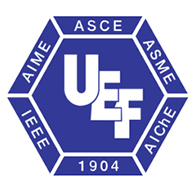Historical Timeline
Having recently been awarded a commendation from the 100 Year Association, the United Engineering Foundation has a long and treasured history of enhancing the engineering profession.
1904
ASME, AIME, AIEE (now IEEE) called the Founder Societies formed the United Engineering Societies (UEF) which received a gift of $1,000,000 from Andrew Carnegie to build a common headquarters building which was built in New York City on East 39th Street. The Societies contributed money to purchase the land.
1906
Building Completed. Founder Societies formed a joint library which became known as the Engineering Societies Library.
1914
The Engineering Foundation was created as a part of the United Engineering Societies to receive an endowment from Andrew Swayze. His continuing gifts totaled $839,000. The earnings of the endowment supported 100’s of research and other engineering profession projects for decades.
1916
United States President Woodrow Wilson asked the National Academy of Science to obtain cooperation in research from government, industry and academia. No funds were available. The UEF agreed to provide financial resources, an office, and provided the first Secretary to what became the National Research Council.
1917
ASCE was accepted as the 4th Founder Society and, after adding 3 floors to the Engineering Societies building on East 39th Street, moved its headquarters to that location.
1931-33
Supported summer school for engineering faculty.
1932-33
Supported courses for unemployed engineers during the Great Depression
1933-63
Supported the founding and early operation of the Engineers Council for Professional Development (ECPD) which later became the Accreditation Board for Engineering and Technology (ABET)
1935
Contributed to the formation of the Welding Research Council.
1958
AIChE was accepted as the 5th Founder Society.
1960
The United Engineering Center (UEC) was established as the headquarters for the Founder Societies and many other societies moved their headquarters to the UEC and became Associates. Those societies included ASHRAE, AIIE, IES, EJC, and more. When formed some 25 years later, AAES established its first offices in the UEC.
1964
The National Academy of Engineering (NAE) was founded. Financial aid was provided by the UEF, which also provided the headquarters for the first six months. The UEF secretary acted as the first NAE secretary.
UEF began offering an interdisciplinary conferences program which, in its life of some 40 years involved over 1,000 conferences.
1996
Merged the Engineering Societies Library with the Linda Hall Library of Science, Technology and Engineering, an independent library, located in Kansas City. The holdings of the ESL were moved to the Linda Hall Library
1998
After a lengthy and complex legal process, the UEF sold the UEC and eliminated its research grants program, distributed the conferences program and awards program to other organizations, focused its activity on a grants program and modified its governance structure. Doing so required the approval of the State of New York and the governing boards of all of the Founder Societies. The UEF moved its headquarters to a leased space
at Three Park Avenue.
2004
The UEF became a virtual organization, operating without a physical headquarters and without any staff members.

